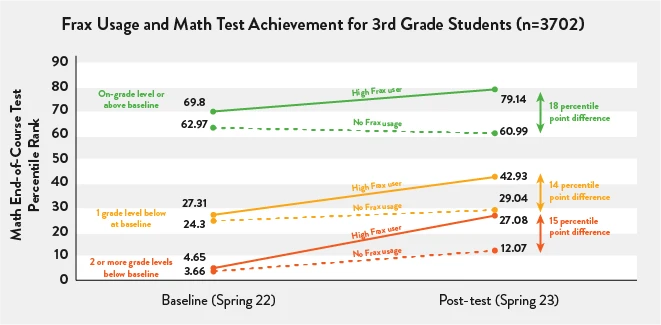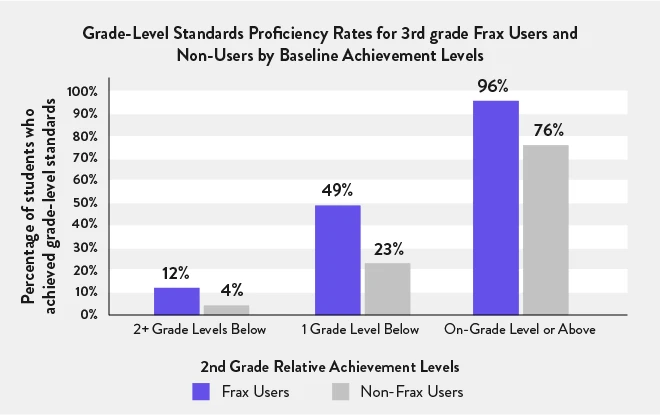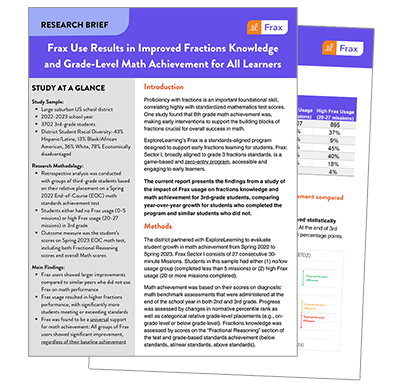
Elementary math lays the foundation for all future math success, and fractions play a critical role. A new research study found that across all achievement levels, third-grade students moved closer to grade-level proficiency when they used ExploreLearning Frax.
Introduction to Frax and study overview
Adaptive and game-based, Frax uses the latest research to help students develop a conceptual understanding of fractions. Frax is an engaging, zero-entry program, allowing all learners to gain fractions knowledge and confidence as they complete carefully scaffolded missions.
Importance of fractions proficiency and early math intervention
Students’ fractions knowledge significantly impacts their present and future elementary math performance, along with advanced math down the road, including algebra.
Research shows that most effective fractions learning occurs when students interact with length models and number lines to foster an understanding of fraction magnitude (size). When students gain a firm grasp of fraction magnitude, they can perform advanced work with fractions, like adding and subtracting, comparing, or locating fractions on a number line. Frax uses the number line as the central representation tool to help students develop fractions skills.
Study participants
The ExploreLearning research team partnered with a large, suburban U.S. school to evaluate the impact of Frax usage on third-grade students’ knowledge of fractions and math achievement. Researchers compared year-over-year student math growth using diagnostic math benchmark assessments administered at the end of the school year (2022 and 2023). The study also measured the changes in grade 3 fractions understanding, using the “fractional reasoning” section of the assessments as a measurement.
The study included 3,702 grade 3 students, of whom 78% were economically disadvantaged. Researchers grouped these students into three relative achievement levels based on their math test scores at the end of second grade: on-grade level or above, one grade level below, and two or more grade levels below. 895 students had high program usage, completing 20+ Frax missions during third-grade fractions instruction.
Key finding: Frax users of all levels experienced significant improvement
Within all three achievement levels, students who used Frax more frequently showed statistically significantly greater gains in percentile rank from pre-test to post-test. At the end of grade 3, Frax users outperformed their peers by 14-18 percentage points.

Key finding: Frax users of all levels were more likely to achieve grade-level math proficiency
Students who used Frax were significantly more likely to achieve grade-level proficiency by the end of 3rd grade, regardless of their starting achievement levels.
49% of students who were one grade level below their peers at the end of grade 2 achieved proficiency in grade-level math standards by the end of grade 3 when they used Frax.

Key finding: Students who used Frax showed higher fractions reasoning knowledge
Across all achievement levels, students who used Frax were significantly more likely to meet or exceed 3rd-grade proficiency standards related to fractional reasoning compared to students who did not use Frax.
Frax users who entered third grade two or more grade levels behind were 2.4x more likely to meet or exceed grade-level standards in fractional reasoning compared to similarly at-risk students who did not use Frax. And the results were just as impactful for students who started the year on grade level. Students with high Frax usage, starting on grade level, were 2.4x more likely to score “above standards” on the fractional reasoning test.
Benefits of Frax's game-based learning approach
Thanks to game-based learning that doesn’t feel like work, Frax students can achieve more in math with Frax as they actively experience success.
Increasing student engagement in math
Frax missions are structured as space-themed challenges, allowing students to learn by doing as they progress through tasks and games. Students stay engaged in the Frax galaxy with enticing visuals, customization, tokens for effort and progress, game-packed Review Rooms, and more.
Supporting diverse learning needs
As the research shows, Frax supports a variety of learners, both those on-grade level and students in need of more targeted math assistance. Frax helps teachers be more effective in the classroom thanks to reporting, professional development, and offline activities to extend or reinforce learning.
Set students up for math success with Frax
The results are clear: Frax helps all students master foundational fractions concepts that support overall student math growth, helping students approach or exceed proficiency standards and succeed in more advanced STEM learning.
Improving math skills doesn’t only benefit students. When students achieve grade-level proficiency, teachers unlock the ability to teach in the ways only they can. They can engage students in math discourse, introduce group projects, and incorporate advanced practice that wouldn’t be possible without students’ shared understanding of foundational concepts.
Try the game-based Frax in your classroom to enhance your fractions unit and increase student achievement!

